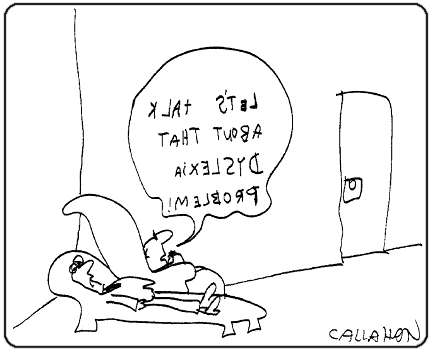
apa itu dyslexia ya? kenapa aku begitu rajen untuk mengulas mcm pengulas sukan utk topik nie ya?
kenapa kenapa? ok, mari teruskan ke agenda utama. jeng jeng.
Perkataan disleksia diambil daripada istilah Yunani, dys yang bermaksud 'sulit dalam...' dan lex (diambil daripada legein) yang bermakna 'bercakap'. Secara kesimpulannya, disleksia bermakna menderita kesukaran yang berhubungan dengan kata atau simbol-simbol tulisan.
"a disorder in children who, despite conventional classroom experience, fail to attain the language skills of reading, writing, and spelling commensurate with their intellectual abilities."
ok maksudnya kat sini, budak tuh ada menghadapi masalah dalam pembelajaran especially. aku merupakan seorang dyslexic kecil kecil dahulu. sedih kot, penyakit nie memang mengurangkan ability kita dalam math dan segala simbol yang lain. nak baca pon tak terus dulu nie. skrg alhamdulilah, penyakit tuh dah ilang kot. kenapa kot? not so sure..
hahaha.
bagaimana nk detect kita nie dyslexic ke tak? oke, kalau kita dyslexic.. kita akan tulis alphabets mcm nie
 begitulah sedikit sebanyak examplenya.
begitulah sedikit sebanyak examplenya.dulu-dulu aku selalu menghadapi masalah tulis a terbalik la. berapa kali kena cubit, sakit ok. bila tang number plak, confuse antara 18 belas dengan 81. 81 tuh aku kata 18. mengamok bapak aku wei, ingat anak dia dungu gila dapat markah dalam kelas 18. menangis bagai nak rabak mata bila kena mcm tuh. aku detect penyakit nie masa darjah 1. masa tadika ok ja. normal. bila masuk sekolah nie dia bengong-lembap skit dalam pelajaran.
here goes its simptoms :
a noticeable difference between the pupil's ability and their actual achievement;
• a family history of learning difficulties;
Dyslexia is most often inherited through the genes. It can also be caused by early ear infections. In both cases it is harder for a young child to distinguish the difference between similar sounding words. The numbers of boys and girls who are dyslexic are roughly the same.
• difficulties with spelling;
Spelling is the activity which causes most difficulty for dyslexic children. Noticing spelling errors in short, simple words is the way in which most dyslexic children first come our attention. Examples of words which cause particular difficulty are: any, many, island, said, they, because, enough, and friend. * aku bla nk spell blue je, mesti aku tulis bleu. waklu, sampai skrg kot.
• confusion over left and right;
A fairly quick way to establish this type of confusion is to ask a child to point to your left foot with his or her right hand. If you try similar instructions - in a non-threatening environment - you will soon be able to see if this causes difficulties or not. (Try it on a colleague - who is not dyslexic - and you can see how a non-dyslexic person is able to sort out the left and right elements quite readily.) You may also notice difficulties with east and west, or in following directions like 'Go to the end of the road and turn left, then right, etc'.
• writing letters or numbers backwards;
You will have noticed some children who mix up 'b' and 'd', or even 'p' and the number 9. These letters are the same in their mirror image, and cause regular confusion for a dyslexic person. Some pupils make a point of always writing the letter 'b' as au upper-case or capital 'B', as they find this much easier to remember in terms of the direction it faces.
• difficulties with math/s;
One feature of dyslexia is difficulties with sequencing - getting things in the right order. Math/s depends on sequences of numbers - 2. 4. 6. 8. etc. Whilst many people are aware that dyslexic children and students have problems with reading and spelling, they do not know that math/s can also be a real challenge
• difficulties with organizing themselves;
Whilst you may quite reasonably think that all children live their lives in a mess, this is particularly so for dyslexic children and students, who may have genuine difficulties with planning and thinking ahead to when a book or pen might be needed next. They can really benefit from help with organizing papers and folders under a simple color-coded system. *tadak-tadak, aku clumsy je ^^,
• difficulty following 2- or 3-step instructions.
Go to Mrs. Brown and ask her if Peter Smith is in school today. Oh, yes, and ask if I can borrow her dictionary' - such an instruction is just too much! It involves both sequencing and memory skills, and you would be very surprised to see a dyslexic child return with the dictionary and information about Peter Smith! Dyslexic children love to take messages as much as any other child, but it has to be a less complicated instruction, e.g. 'Ask Mrs. Brown if I can borrow her stapler'.
early detection is really help! so. kalau budak tuh lembap atau malas belajar, mesti budak nie kena penyakit nie. jangan main sebarang tuduh je cikgu cikgu oi. luaran nampak hepi, dalaman. perghh.
btw! ramai jugak yang dyslexic dari kalangan famous person.

orlando bloom yang handsome lagi nie pon sama.
 inventor of Faraday's Law pon sama. seb baek law dia tk masuk spm 09. phew, selamat!
inventor of Faraday's Law pon sama. seb baek law dia tk masuk spm 09. phew, selamat!ini ternyata, dyslexic brings you a good advantage.
kepada manusia manusia yang ada symptom mcm i nie, jangan malu ok.
try to improve yourself more..
dan kepada bukan dan tkda symptom mcm i.
jangan laa gelak wei... kang anak kau dapat penyakit nie, baru kau tahu best ke tak.
thanks god. I'm glad, i still have brain ;)
kepada manusia manusia yang ada symptom mcm i nie, jangan malu ok.
try to improve yourself more..
dan kepada bukan dan tkda symptom mcm i.
jangan laa gelak wei... kang anak kau dapat penyakit nie, baru kau tahu best ke tak.
thanks god. I'm glad, i still have brain ;)


No comments:
Post a Comment